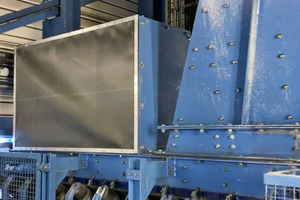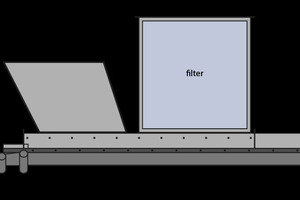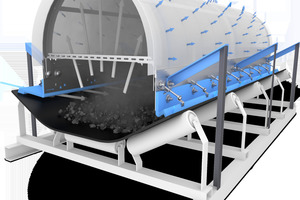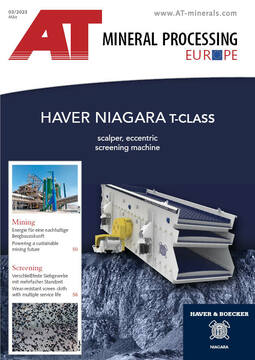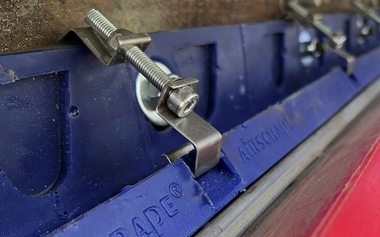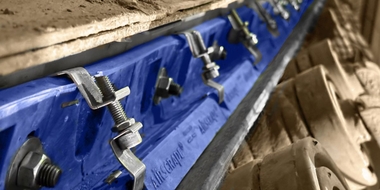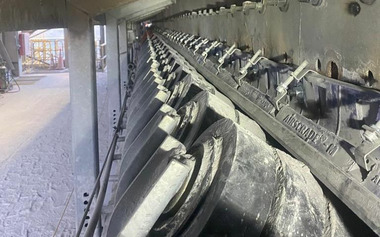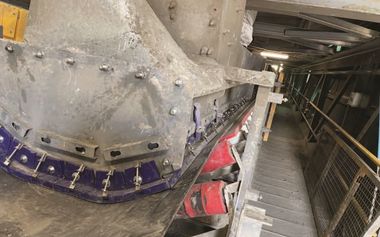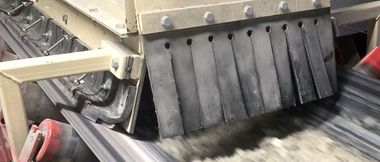Smart box: The DustScrape dust filter
In this case, the fall height is the problem. Despite the closed systems at the transfer points for fine bulk materials, the drop height in the system creates an air suction effect that extremely increases the pressure inside the closed chute in the next step. ScrapeTec Trading GmbH from Kamp-Lintfort in Germany knows the problem. “It is typical of the fine materials in cement production. The dust development in this area is enormous. Even if our customers have already used our innovative side seal AirScrape and the TailScrape at the back of the chute, there are massive amounts of dust at the exit of the transfer. That’s why we like to talk about our complex dust protection solution, in which several of our products work together to reduce dust emissions to almost zero,” says ScrapeTec founder and owner Wilfried Dünnwald, who developed the DustScrape and personally oversees many customer projects.
In the case mentioned, the DustScrape would be the missing additive. As a rule, the DustScrape is offered as a dust protection filter tunnel, which is installed in the direction of belt travel as a calming zone after the chute. AirScrape skirting completes this solution. The robust filter cloth lets the air through. The filtered dust remains with the bulk material in the conveyor. “In the case of particularly high pressure developments, however, we offer the DustScrape as a box in order to be able to withstand the loads. The box itself offers more stability and the filter cloth is mounted more sturdily at the same time. In special cases, for example with ATEX requirements, we use stainless steel filters.”
In the product description of the DustScrape at https://scrapetec-trading.com/produkte/dustscrape you can clearly see the structure of the DustScrape. A tunnel covered with the filter cloth, which is sealed with the AirScrape on the side towards the belt. The box shape of the DustScrape cannot be seen there yet. This solution only developed in the course of various projects with particular pressure loads. But here, too, the sides of the box construction are provided with the AirScrape Seitan seal. If you are not yet familiar with the AirScrape: The innovative seal works contact-free and hovers over the belt. The special arrangement of the lamellas of the seal results in what is known as the Venturi effect: the outside air is sucked inwards, which means that no dust or spills escape through the seal gap to the outside. The difference to conventional seals is the non-contact operation of the AirScrape. Because there is no friction, and therefore no wear and tear, which normally impairs the effectiveness of the seal after a certain period of use. The TailScrape at the rear of the chute works according to the same principle. Ideally, an effective dust protection solution from ScrapeTec includes AirScrape, TailScrape and DustScrape. Because only the seals that work according to the Venturi effect ensure that the DustScrape works optimally. If you also want to be sure that the belt always runs perfectly and the seals can therefore work as effectively as possible, ScrapeTec also offers the PrimeTracker as a conveyor belt lane-keeping assistant and the stabilizing SureSupport, which prevents belt deformation when heavy bulk goods impact. But the DustScrape dust filter “floats” above everything else.
Conclusion: If you rely on effective dust protection, you invest in long-term cost savings. Why? On the one hand, there are no cleaning, maintenance and repair costs. In addition, there is health protection for the employees and thus better working conditions, which lead to fewer absences. All in all a “smart box”.
Hall 4, stand B 12

